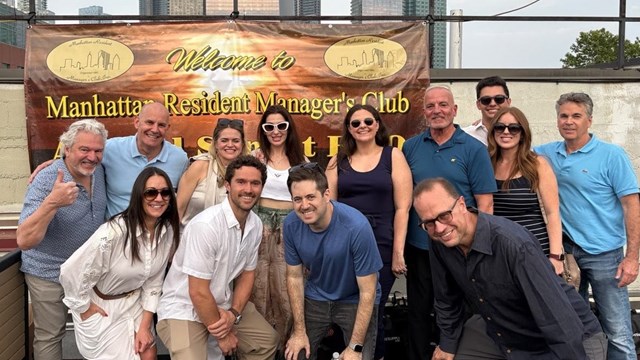
In 1932, when Josephine Baldizzi was six, her mother Rosaria, used to bathe her in the kitchen’s slop sink in their five-story walkup tenement building at 97 Orchard Street. On her walk to school, she wore her father Adolfo’s size 9 shoes and hand-me down clothes. Rosaria tended to the household, and for a time worked long hours in the nearby garment factory. Adolfo was a cabinetmaker, who carried around a toolbox, and did odd jobs to support his family.
Josephine and her brother John shared the small back room, sleeping together— head to toe—in the same folding bed. Their parents slept in the front room. The apartment had the bare essentials, but thankfully, there was running cold water, gas, and electricity. Small amounts of hot water came from a heater attached to the stove, which provided the only heat during the long cold winter months. The only refrigeration was a small “ice box” kept on the fire escapes. The toilet was in the hallway. Rosaria washed clothes in the tub with a scrub board.
Reliving the Past
Stories like these and more about the immigrant families that settled on the Lower East Side are what the Tenement Museum at 97 Orchard Street bring to life every day in its exhibitions and tours. Museum visitors are literally transported back in time to a harsher way of life than what they are presently used to. The 1863 building located between Delancey and Broome streets, is a pre-‘Old Law’ tenement built before the city had laws governing housing construction. Tenement hallways were dark, foul smelling and dank without any lighting or outside windows. Apartments were often built in configurations where tenants received no light from the outside—there was no interior plumbing either. Between 1820 and 1860, the population of New York City grew from 123,706 to 813, 699, with another 266,661 persons living in Brooklyn, according to “A History of Housing in New York City” by Richard Plunz. And that same time period represented the greatest influx of new immigrants—nearly four million newcomers arrived in the United States—and 10 percent of them chose to call New York City home.
By the early nineteenth century, the Lower East Side had developed into a bustling manufacturing center and shipyards and slaughterhouses dominated the neighborhood’s waterfront.
This area of the Lower East Side where Eastern European and German-Jewish immigrants first established their homes and businesses—from the Bowery east to Pitt Street then above Delancey Street north to Fourteenth Street and from Second Avenue to the East River—was called Kleindeutschland or “Little Germany.” No sanitation or garbage collection services existed and waste was routinely piled high in the street, becoming a breeding ground for vermin and diseases of the day. The German Catholic and Jewish immigrants that populated the Lower East Side worked as tailors, shoemakers, cabinetmakers, upholsterers, and other skilled professions. They were also responsible for starting the beginnings of the trade movement in this country.
By 1872, Kleindeutschland was the equivalent of the fifth-largest German city in the world and virtually all of the immigrants lived in tenements. And from 1880 to 1890, some 60,000 Jews, mostly from Eastern Europe, found their way to the Lower East Side, according to the museum’s research. By 1864, approximately 500,000 of New York’s 800,000 residents (more than 62 percent) lived in 15,500 city tenements.
Each three-room flat in the building was only about 325 square feet—and its front room served many functions: a sewing room by day, a dining room, parlor and bedroom by night.
When 97 Orchard Street was built, it had twenty apartments and two basement-level storefronts. Each floor had four three-room apartments, two in the front and two in the back of the building. When constructed, 97 Orchard Street had no indoor plumbing, no gas, and only one room in each apartment benefited from direct sunlight. Each apartment was, however, equipped with two fireplaces. Electricity wasn’t available in the building until around 1924.
A tenement apartment, the museum reports, probably rented for about $8 to $15 a month in the 1870s. That may sound inexpensive, but you must remember that the unskilled laborers of the day only earned about $1.75 for an entire ten-hour day, thus making rent an expensive proposition for the newcomers.
The Tenement Museum Today
Raymond T. O’Keefe is presently the museum’s chairman. A 39-year veteran in commercial real estate brokerage, O’Keefe had served on the board since 1997 and was appointed chairman in 2004. “I became involved with the museum because I believe in its mission of promoting tolerance. By preserving and interpreting this building, the museum preserves a unique part of New York City’s history and chronicles the development of housing in the city.”
“The mission of the museum,” explains O’Keefe, “is by telling and interpreting the history of the Lower East Side and the immigrant waves that came through it to promote understanding and tolerance of different cultures to present day. It’s not just about the past, it’s about the present and the future,” he says. It’s how the city dealt with housing and immigration and integrating all different cultures into that melting pot we call America, he adds.
The idea for the museum, he says, belongs to scholar and social activist Ruth J. Abram, who began searching for a way to tell the immigrant story. In 1985, Abram and curator Anita Jacobson scoured neighborhood after neighborhood in search of a location to house their fledgling enterprise.
In 1988, they literally struck gold. Jacobson spotted a for rent sign at 97 Orchard Street, a dilapidated storefront within a five-story tenement building on the Lower East Side. The building, as it turns out, was perfect and a virtual time capsule of the age that Abram and organizers sought to portray. Researchers also found that over 7,000 people from over 20 countries had actually lived in the Orchard Street tenement between 1863 and 1935.
Difficult economic times and stricter housing laws enacted during the Great Depression forced the landlord in 1935 to evict the tenants in the 20 apartments. The building remained unoccupied for more than 50 years until its discovery by the museum organizers.
Show Me the Money
The museum’s annual budget of around $4 million, says O’Keefe, is mainly supported by grants, public donations and corporate contributions, ticket and merchandise sales and by some city funding.
“We still need to raise more than half of our funds through grants, contributions, and government support,” O’Keefe says. The city also lends its support in the budget and about another third is raised through ticket sales and revenue from the museum gift shop. “The city is very, very generous to us,” he adds.
Four tours are presently on the museum schedule. “We tell the story about the beginnings of the garment industry—when it was first piecework done in apartments, and it moved on later to factories. We tell the story of the family who actually did the piecework on their apartment – in their living quarters – there was also four or five people working on manufacturing garments,” O’Keefe adds.
“We tell the story in another apartment about a family where the family, and the father, particularly the breadwinner, worked in a garment factory because this was the center of the garment industry. We have two other apartments that were restored to a period of economic hardship in New York City; one in the 1870s after the Panic of 1873—and the last one, the late 20s and early 30s,” during the time of the Great Depression, he says.
The museum’s current tours include “Piecing it Together: Immigrants in the Garment Industry,” which tells about the Levine and Rogarshevksy families and the birth of the city’s garment industry. “Getting By: Immigrants Weathering Hard Times,” follows the exploits of the German-Jewish Gumpertz family, and the Sicilian Catholic-Baldizzi household that struggled to get through hard economic times. Both of these one-hour tours are free to members; adult admission is $15, students and seniors, $11. “The Confino Family Apartment” tour is a living history about a Sephardic Jewish family that emigrated from Kastoria, what now is Greece. This tour is also one-hour and costs $14 for adults and $10 for students and seniors.
O’Keefe says that the museum wants to utilize its current building space while at the same time look for ways to make the museum story and its mission portable. “We have a website. We have people going around to schools. We have actresses who dress in period costume. We have a girl from Kastoria, a Sephardic Jewish girl whose family lived in the building, and some actresses going around in that costume and discuss what it was like to be a teenager and a girl in that era.”
Future plans, he notes, include the addition of a fifth tour that will examine the history of Irish immigration and a family that lived at 97 Orchard Street in the 1860s. “Right now we estimate that we’re turning away 20 percent of our business, there are 20 percent more that want to get in that can’t because tickets are sold out or we’re over capacity. If we had the Irish apartment, the fifth apartment, that will address that.”
This apartment, O’Keefe explains, will give the museum additional tour capacity and the ability to learn more about the Irish experience. “When the building was first built by the German-Americans,” he says, “there was a saloon on the ground floor—Steiner’s German Beer Saloon. And we’re working on the research to recreate that. What research is telling us is that those beer halls were a local political gathering place at the same time. Not just a place for people to go drink beer. They were a center of political activity, of meeting for the German Americans.”
Another future project, he continues, is recreating an environment so people would understand the sanitary conditions immigrants lived in. And that might be another tour exhibit down the road.
“As far as we know, this is the only museum, the only building that documents the urban working immigrant poor community in the United States, which is a very large part of our experience. Millions of people immigrated.
“We’re an asset to the city, many many foreign visitors, many many tourists around the world come here for the unique part of the New York story and the American story,” says O’Keefe. “We find people from other countries are very interested in the Tenement Museum, the Lower East Side – because they’ve read about it and heard about it. It’s a unique part of the American Experience.”
Debra A. Estock is Managing Editor of The Cooperator.





2 Comments
Leave a Comment